The operating principle of an air conditioner is almost the same as that of a home refrigerator
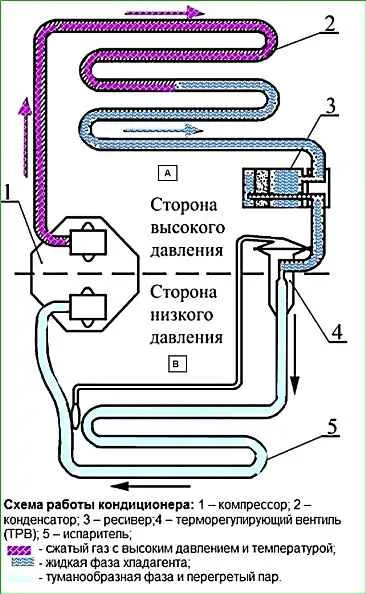
When the air conditioner is turned on, the air conditioner compressor starts working
The compressor constantly compresses and circulates the refrigerant
During compression, the gaseous refrigerant passes into a liquid state, condensing in the heat exchanger-condenser with the release of heat.
Next, during the reverse transition to a gaseous state, heat absorption occurs in the heat exchanger-evaporator.
The evaporator 5, which is located in the car's interior, constantly reduces the air temperature
The refrigerant transfers heat to the condenser 2, which is located outside the interior, and is released from it. This cycle is repeated, and heat is constantly removed from the passenger compartment.
With the help of control, the actuators maintain the required microclimate.
The refrigerant used in the Chevrolet Niva is R134a.

Compressor 1, Fig. 2, is the main and most complex unit of the system.
The compressor compresses the low-temperature and low-pressure gaseous refrigerant, converting it into high-temperature and high-pressure gas.
The compressor is mounted on the engine bracket on the right side.
The compressor is driven by a poly-V drive belt from the car engine through an electromagnetic clutch.
When voltage is applied to its winding, the driven disk and pulley rotate synchronously, setting the compressor shaft in motion.
The compressor is lubricated with special compressor oil circulating throughout the system together with the refrigerant.
The air conditioning system uses compressor oil AT41244 (ISO 150).
The volume of refrigerant for air conditioning system refill – 0.4 kg.
Compressor oil volume – 0.22 l.
Air conditioner condenser 6 is aluminum.
Condensation (transition to liquid state) of the refrigerant pumped by the compressor occurs in it with the release of heat into the atmosphere.
For better blowing, the condenser is installed in front of the radiator of the cooling system.
Evaporator 4 is an aluminum heat exchanger.
The transition of the refrigerant from a liquid to a gaseous state (evaporation) occurs in it with the absorption of heat.
The evaporator is installed in the instrument panel on the path of the incoming air flow, which ensures a decrease in its temperature.
Receiver-dryer 7 is installed on the outlet pipeline of the condenser in front of the evaporator and serves as a reservoir for liquid refrigerant, cleans it from foreign impurities and water.
The receiver-dryer can be equipped with a viewing window to monitor the amount of refrigerant.
The thermostatic expansion valve is installed on the evaporator and regulates the amount of refrigerant entering the evaporator. The expansion valve is a device that ensures a change in the system's performance depending on the conditions and operating mode.
The pressure sensor sends a signal to the ECM controller to turn the air conditioner on/off depending on the pressure in the high-pressure pipeline

The air conditioning system is controlled manually by pressing button (A/C) 1, Fig. 3, air conditioning control, temperature control knob 5 with blue and red zones, switch 2 for the speed of the heating system fan motor, switch 4 for distributing air flows in the passenger compartment (up, down, central part)
Air conditioning system diagnostics
Diagnostics are based on the current pressure readings in the air conditioning system
Pressure reading reference table
Air conditioning pressure readings depending on temperature:
Outdoor temperature - Low pressure line (L.P.) (kg/cm 2) min - max - High pressure line (H.P.) (kg/cm 2) min - max
- 15.5 - 1.5-2.3 - 9.5-13.0;
- 21.0 - 1.5-2.3 - 12.5-17.5;
- 26.5 - 1.5-2.3 - 14.0-20.5;
- 32.0 - 1.5-2.5 - 16.0-24.0;
- 38.8 - 1.5-2.5 - 18.5-25.5;
- 43.0 - 1.5-2.5 - 22.0-28.0
If the readings are outside the ranges shown in the table (Pressure Reading Reference Table), the system is probably faulty
The following are the most likely causes of faults identified based on the pressure readings of the low or high pressure gauge. The figure shows a pressure gauge reading with a significant deviation from the norm
Note: The following "possible causes" are listed taking into account the statistical probability of the occurrence of faults
Pressure gauge readings:
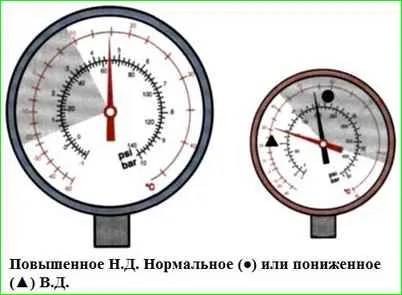
Possible causes of malfunctions:
The suction and drain hoses were swapped when connected to the compressor
The compressor's electric clutch slipped or did not engage
The expansion valve is stuck in the open position. If the compressor has a variable displacement, there will be small but rapid fluctuations in low pressure
The compressor displacement control valve is incorrectly adjusted or faulty
The compressor is damaged
Pressure gauge readings:
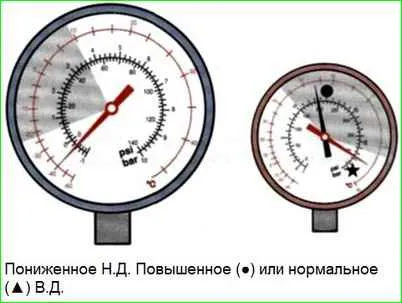
Possible causes:
- - the filter is saturated with moisture;
- - the compressor displacement control valve is jammed in the position providing maximum displacement
Readings pressure gauges:
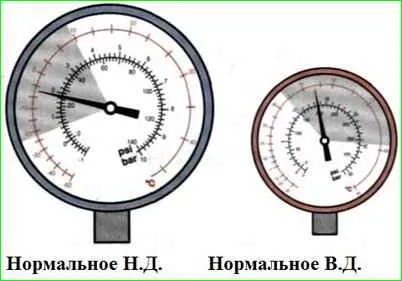
Possible causes:
- - warm air has entered the evaporator unit or the passenger compartment;
- - warm air has entered the radiator;
- - ice on the evaporator core
Pressure gauge readings:

Possible causes:
Normal at very high ambient temperature (>43° C)
Excess refrigerant by 30-35%
Condenser overheating
Presence of air in the air conditioner hoses/pipes
Faulty compressor displacement control valve
Clogging of the high-pressure line between the compressor and the evaporator, but after the high-pressure measurement point
Manometer readings:
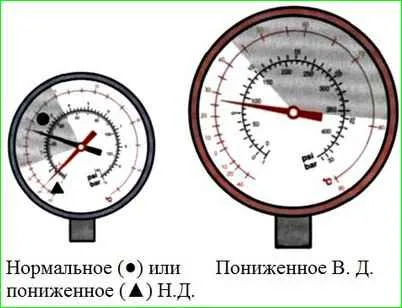
Possible causes:
Normal at very low ambient temperature (<5° C)
70-75% refrigerant deficiency. Check for leaks
Expansion valve stuck closed or expansion valve clogged
High or low pressure line clogged between filter and evaporator
High pressure line clogged between compressor and evaporator, but before high pressure measurement point
Compressor damaged
Manometer readings:
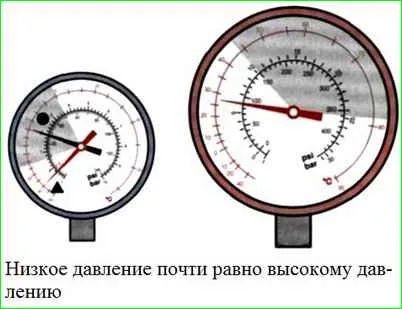
Possible causes:
- - compressor belt slipped. The probable cause is the misalignment of the pulleys;
- - the compressor clutch has slipped or has not entered the rhythm;
- - the compressor is damaged;
- - the compressor displacement control valve is faulty.
Possible malfunctions and troubleshooting methods
The air conditioner is noisy
Note. The noise heard when the air conditioner is first turned on is not caused by a malfunction (the electromagnetic clutch is turned on and the compressor is running).
In case of constant noise that is heard even a few minutes after the air conditioner has stopped working, check for one of the above causes of the malfunction and take appropriate measures.
- the belt is worn out or has slipped
Check the wear and tension of the belt
- the tension pulley is noisy
Replace the tension pulley
- the electromagnetic clutch disk has slipped
It is necessary to provide a distance of 0.3-0.5 mm between the compressor pulley and the electro-clutch disk
- vibration and resonance of the compressor support disk
Check the tightening torque of the bolts and the correct position of the disk. Check the alignment of the pulleys
- the expansion valve "whistles"
If the noise is constant, the evaporator assembly must be replaced
- incorrect condensate drainage
If the heater fan operates on suction, install a shut-off valve on the outer end of the condensate drain hose so that the condensate is discharged to the outside and is not pumped back, making a gurgling noise.
Warning. In the following cases, several faulty components of the air conditioner create abnormal pressure at the inlet and outlet.
This phenomenon causes noise in the compressor, which is actually caused by one of the following reasons and is not related to the compressor.
Incorrect amount of refrigerant
Air, non-condensable gases or moisture in the air conditioner
- Incorrect amount of refrigerant (30-35% more or 70-75% less):
Remove the refrigerant from the air conditioner. Evacuate non-condensable gases and moisture from the air conditioner by turning on the vacuum pump for at least 15 minutes.
Check the system for leaks using a pressure gauge. Fill the system with the recommended amount of refrigerant, as well as the oil removed from the system along with the refrigerant
- Expansion valve is stuck in the closed position / Expansion valve is clogged:
Replace the evaporator assembly. Evacuate non-condensable gases and moisture from the air conditioner by turning on the vacuum pump for at least 15 minutes.
Fill the system with the recommended amount of refrigerant, as well as the oil removed from the system along with the refrigerant
- Compressor displacement control valve is faulty:
Remove the refrigerant from the air conditioner. Replace the compressor.
Pump out non-condensable gases and moisture from the air conditioner by running the vacuum pump for at least 15 minutes.
Fill the system with the recommended volume of refrigerant, as well as the oil removed from the system along with the refrigerant.
- the air conditioner circuit is clogged:
Determine the location of the blockage by identifying a section in the circuit with a sharp temperature difference (high temperature above the blockage, low temperature below the blockage).
Remove the refrigerant from the air conditioner. Replace the clogged component.
Flush the air conditioner thoroughly using a special agent and replace the drying filter to prevent dirt sediment from settling in the circuit due to clogging.
Pump out non-condensable gases and moisture from the air conditioner by turning on the vacuum pump for at least 15 minutes.
Fill the system with the recommended amount of refrigerant, as well as the oil removed from the system along with the refrigerant.
- the filter is saturated with moisture:
Remove the refrigerant from the air conditioner. Replace the air conditioner filter. Pump out non-condensable gases and moisture from the air conditioner by turning on the vacuum pump for at least 15 minutes.
Check the tightness of the system using a pressure gauge. Fill the system with refrigerant and oil.
The air conditioner emits an unpleasant odor
- under certain conditions, mold and bacteria (usually contained in the air) may form on the surface of the evaporator, which cause an unpleasant odor.
Sometimes the odor occurs due to a clogged condensate drain hose:
Use an antibacterial agent to treat the evaporator, clean the condensate drain hose
Advise the customer to turn off the air conditioner a few minutes before turning off the car engine, leaving the blower fan on (this will dry the evaporator core from moisture, which promotes bacterial growth)
The condenser does not dissipate heat in sufficient volume
- The air duct is clogged with dirt accumulated on the heat exchangers: water radiator, condenser (probably after 25,000-30,000 km)
Clean the radiator and condenser thoroughly
- The pressure switch or temperature sensor does not switch off when the set pressure and temperature level is reached
Disconnect the control units using the appropriate electrical contact. If necessary, replace the faulty component
- The electric fan does not work
Connect the electric fan directly. If the fan still does not work, it must be replaced
- The electric fan is not working properly (incorrect rotation direction)
The fan operates in suction mode if it is located between the heat exchangers and the engine, and in exhaust mode if it is located between the heat exchangers and the outside air intake
- The water in the engine cooling system is overheated
Check the serviceability of the original engine water cooling system
- The condenser is located incorrectly
Make sure that the distance between radiator and condenser is 15-20 mm; if the distance is observed, check the correct location of the air ducts
The compressor clutch slips or does not engage
- Insufficient refrigerant:
Find a refrigerant leak. Remove the refrigerant from the air conditioner. Pump out non-condensable gases and moisture from the air conditioner by turning on the vacuum pump for at least 15 minutes.
Check the tightness of the system using a pressure gauge. Fill the system with the recommended amount of refrigerant, as well as the oil removed from the system along with the refrigerant
- the electro-clutch circuit is de-energized / Power supply to the circuit is unstable:
Disconnect the electro-clutch wire from the circuit and connect it to the "+" terminal of the battery via a 7.5 A fuse
Replace the compressor assembly.
If the electro-clutch engages, check the pressure switch, thermostat, air conditioner control switch and electrical contacts
- incorrect distance between the compressor pulleys and the electro-clutch disc:
The distance should be 0.3-0.5 mm
Ice on the evaporator tubes
Note. This can happen within a few minutes after switching on, which will lead to a sharp decrease in the air flow blown out of the deflectors
- incorrect operation of the blower fan:
The switched on air conditioner should ensure that the fan operates at least at the first speed. Otherwise, check the correctness of the electrical connections
- the compressor displacement control valve is faulty:
Replace the compressor
The compressor is damaged
- the valves are bent, jammed:
Remove the refrigerant from the air conditioner
Remove the compressor
If the compressor is jammed, flush the air conditioner using a special agent and replace the drying filter to prevent dirt sediment from settling in the circuit due to clogging
Install a new compressor
Pump out non-condensable gases and moisture from the air conditioner by turning on the vacuum pump for at least 15 minutes. Check the system for leaks using a pressure gauge.
Fill the system with the recommended amount of refrigerant, as well as the oil removed from the system along with the refrigerant
Hot air enters the passenger compartment
- the heater radiator water valve (if equipped) does not close properly:
Check the lever mechanisms and/or the valve motor. Disconnect the radiator if necessary
- the air mixing and/or air recirculation flaps are not tight:
Check the lever mechanisms and/or the valve motor
- the evaporator insulation is not tight:
Make sure the evaporator is sealed and connected to the original radiator properly, preventing warm air from entering from outside





